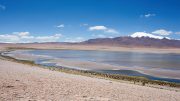BHP’s (NYSE: BHP; LON: BHP) Escondida copper mine in Chile, the world’s largest, will stop drawing fresh water from the Atacama salt flat, using instead desalinated water brought from its coastal plants.
The miner’s decision comes as the country is stepping up protections for a natural resource that has been depleted after decades of mining activity in and around the Atacama desert, the driest place on Earth.
The Atacama region, which hosts some of the world’s largest copper and lithium mines, is occasionally hit by heavy rains and floods. According to Chile’s water authority DGA, the area has become drier over the last decade, adding an extra layer of difficulty to mining companies with projects and operations nearby, at times when the industry’s demand for water is expected to soar as ore grades decline.
BHP’s decision to withdraw applications to renew a permit to pump 428 litres per second of underground water is expected to reduce pressure on the vast, lithium-rich salt flat. The plain is home to top lithium miners Albemarle and SQM, which also extract fresh water from underneath it.
BHP already gets more than 40% of the water it needs from the ocean and has vowed to stop using fresh water drawn from surface and underground sources in Chile by 2030.
In 2018, the mining giant spent US$3.43 billion on a desalination plant for the Escondida mine, which includes two pipelines to transport the water 3,200 meters above sea level.
Antofagasta’s (LON: ANTO) Zaldívar copper mine is seeking to renew its permits to draw water from the flat. Unlike Escondida, it has no backup plan. The mine, which is approaching the end of its life, will have to close down if its water license isn’t renewed, the company has warned in the past. Even with water use permits in place, Zaldívar will probably stop producing in 2029.
The current license allows Antofagasta to pump 500 litres per second through 2025, and the miner is asking for a license to pump 213 litres per second through 2029.
Other than their high cost, desalination plants pose worries related to the waste miners generate. That product — brine — is usually pumped back into the reservoir where the water was taken from. This causes an imbalance in the overall water composition, which is harmful to the environment.
— This article first appeared on our sister publication, MINING.com.





Be the first to comment on "BHP to supply desalinated water to Escondida"